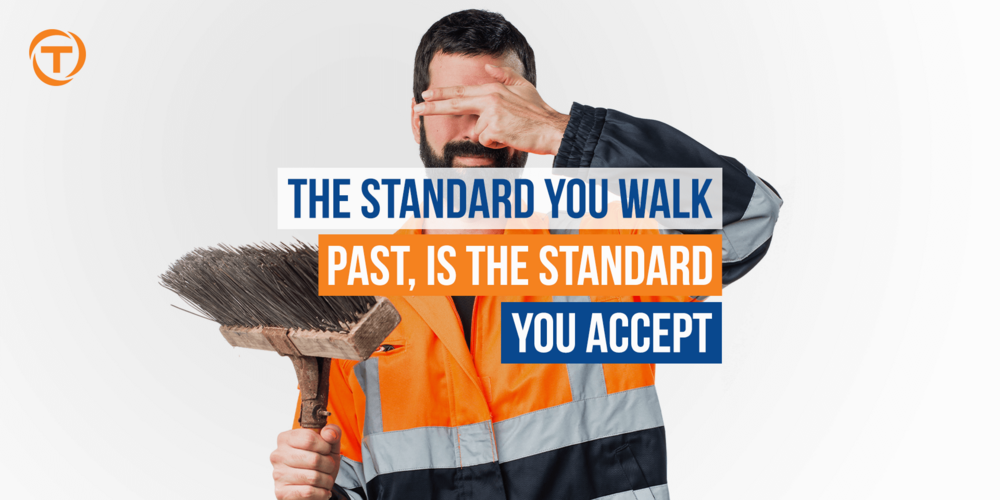"The standard you walk past, is the standard you accept. That goes for all of us, but especially those, who by their rank, have a leadership role." Lieutenant General David Morrison, 2014
Lieutenant General Morrison’s stand against disrespectful behaviour within his army goes down in history as one of the strongest leadership positions in history. He showed an entire nation what it means to lead by example. He chose not to walk past the allegations within his ranks but to see it, face it and apply good moral judgment. He held people accountable and, as the leader set the standards of what is acceptable.
It’s a stance that can and should be applied to all leadership roles – from the construction site, to manufacturing and the CEO offices of global corporations.
Leaders are always leading by example
As a leader you are always leading by example, and you set the tone and standards of what is acceptable. You are the conscience of the team and have the responsibility to hold up the values and standards of your organisation.
By choosing to take action – or not to – you send your team a message on what you will tolerate. Choosing to ignore, is also leading by example. It’s called ‘wilful blindness’ and it’s a leadership style than can lead to damaging the wellbeing of employees and the reputation of your company.
Whether it’s small things like poor workmanship, and untidy workspace that you choose to let pass, or more serious issues like disrespectful behaviour or failure to follow safety procedures – how and if you choose to notice and react – matters.
It can mean the difference between:
a highly engaged or dysfunctional team
a diverse, accepting team culture or one of discrimination and disrespect
a productive and efficient workplace or a disorganised, untidy mess
a safe working environment with minimal injuries or a dangerous site risking injury or life
a thriving organisation or an organisation bogged down in HR issues
So, what are some things you shouldn’t turn a blind eye to? Here is a list of eight common things you might come across in your workplace, and what you can do as a leader to make sure you uphold high standards in work ethic, quality and behaviours.
Poor workmanship – as long as it looks OK
A 2019 report found sloppy and sub-standard work in Australia’s construction industry over the decade would cost a hefty $6.2 billion to fix. Australian Property Journal, / CFMEU 2019
Not only will poor workmanship not go unnoticed, but someone down the line will have to fork out the money to pay for it. But it’s not just about the cost of repairs and the dissatisfaction it will cause for the end user. There is the cost to you and your company’s reputation. The quality (or lack of it) in the standard of work you accept and deliver, may mean you lose out on future jobs.
To prevent poor workmanship, take the time to stop and go through with your team about the standard of work you expect and the reasons why. When hiring new team members, ask to see their work and keep an eye on the quality in their first days. In this way, you will surround yourself with a team of highly skilled employees who deliver work that is up to the standard you want to uphold.
Shortcuts - no one will know
Having a particularly large workload, and being told to work ‘efficiently’ creates an ideal scenario for workers to take shortcuts even when they know all the risks involved - Psychology Today, 2018
Shortcuts are a bad idea for too many reasons to name. In 2010, BP was responsible for one of the largest marine oil spills in history resulting in workplace injuries, loss of life and an environmental disaster. A report found it was the result of shortcuts taken by team members because the project was running weeks behind schedule, and millions of dollars over budget.
avoid breeding a culture of shortcuts, raise it with employees you see taking shortcuts – every time. Also, take note of how you word your sentences when delegating work. Studies found employers who push phrases like ‘get the job done’, and 'finish it' translate to many employees as an indirect way of saying ‘at all costs’, including bending rules and skirting procedures. So, make it a point that efficiency shouldn’t come at the cost of safety and quality.
Safety – it’ll be alright
79 per cent of all work-related fatalities come from three key occupation groups; machine operators, labourers, and technicians and tradespeople. Safe Work Australia, 2019
You may feel like a parrot constantly repeating to the team to wear their hard hats, goggles and hi-vis vests – but it must be done because it can mean the difference between serious injury or even death.
If you, as a leader, turn a blind eye to any safety procedures, your team will assume you are OK with it, which also risks your team avoiding other safety procedures.
Like many organisations, Trojan Recruitment Group has a zero-tolerance stance when it comes to compromising safety procedures. Remind your team of the policies and procedures whenever you see a safety breach. If it’s a problem you see regularly, call a group huddle and get to the root of the problem – why is everyone avoiding a particular safety procedure
Disrespect – only pulling your leg
Almost 20 per cent of workers have experienced discomfort due to sexual humour – Safe Work Australia 2017
Passing off disrespectful and discriminatory behaviour as a ‘bloke’ thing or as a ‘joke’ may set a precedent for this type of behaviour to snowball out of control and damage the culture and employee engagement within your team.
As a leader, it’s best to have a no tolerance policy towards any form of disrespect when it comes to race, religion, gender and sexual orientation. Not only because, as a leader you will avoid potential legal action, but because it is the right thing to do – and research shows organisations who embrace diversity outperform those who don’t.
To foster an inclusive workplace – a 2020 RMIT University report found managers behaviour played a key role in creating a respectful work environment and preventing and holding individuals accountable for their behaviour. So, the first thing to do is be respectful as a leader. Set the right example. And then aim for the entire team to uphold the same values at work.
Pilfering or outright stealing – it’s just some duct tape
Employee theft costs businesses $1.5 billion in lost revenue each year. Australian Federal Police, 2019
Whether it is just a packet of post-its or leftover material, taking items for your own personal use is still stealing - no exceptions. Letting it slip once will send the message you as a leader are OK with it. Then it’s a question of where you draw the line – what is OK to take, and what isn’t?
To make sure there are no mixed messages about pilfering, be clear with your team from the start.
If you work on site and don’t mind employees taking leftover materials home, set out a clear policy on what can and can’t be taken and when. If you work in a kitchen and are happy for staff to take meals home at the end of their shift, set out a clear policy. Every workplace is different so make the policy and consequences clear and remind employees of these rules regularly.
What the bosses don’t know – won’t hurt them
…firms with a high-trust environment, where employees can collaboratively and transparently share knowledge, gain stock returns two to three times higher than the industry average and have 50 per cent lower turnover rates than competitors. Harvard Business Review, 2019
Research says most of us withhold, hide or conceal information because of fear. It could be fear of losing status and power, fear of judgment by others or the fear of people we dislike or distrust. In most cases, the aim of keeping quiet is to protect ourselves, however the same research also confirms that the person who hides information willingly is 17 per cent less likely to thrive, learn and grow at work.
To foster a culture of openness and trust in the workplace, show your team they can talk about their concerns, errors, mistakes and issues. Reaffirm this by sharing your own mistakes and raising issues that may be of a sensitive nature. In this way, you show the team it’s OK to speak up and that you have a ‘learn from our mistakes’ approach and that they will not be judged.
Messy and disorganised workspace – it’s a construction site…
…our brains like order, and constant visual reminders of disorganisation drain our cognitive resources and reduce our ability to focus. Harvard Business Review, 2019
Yes – a construction site can be a tidy and organised workspace, as can an office, warehouse, plant, or any other workspace. It may not seem like it, but there are ways to bring a form of order to any working environment.
Establishing rules that creates accessibility and minimises risk of injuries through a tidy approach to work, tools equipment and the like is a prerequisite of an efficiently run workplace.
To create order, be a good example of what an organised workspace looks like. Set up some basic rules to eliminate the key creators of chaos. As an example, if you are on a site, decide where materials can be offloaded and stored, where all scraps, rubbish and leftovers need to go, and making sure tools are not left lying around. Respect the rules as a leader and repeat them during Toolbox Talk or whenever you see an employee not sticking to them.
Belittling, gaslighting and talking down to team members – what do you know?
Like most forms of workplace harassment, the impacts of gaslighting can spread beyond the people involved. Once there’s a crack in a team, everyone feels it. HRM, 2019
Seeing one team member embarrass, speak down to, belittle or gaslight another, can set off a domino effect within the team. What starts off as disrespect or subtle manipulation, can lead into bullying and harassment – setting a dangerous standard that becomes acceptable throughout the workplace.
To avoid a toxic culture that affects the wellbeing of employees - keep an eye out for this kind of behaviour taking place. Ensure you don’t find yourself reacting impulsively and setting a bad example yourself. Not reacting and reprimanding employees who behave badly poses risks for both your employees’ wellbeing and the organisation’s reputation.
Summary
Leaders play a key role in setting the standard of what kinds of behaviours are acceptable at work.
Choosing to turn a blind eye willingly to bad behaviours can have dire consequences when it comes to the wellbeing of employees and reputations of leaders and organisations.
Employees follow by example. What the bosses do or don’t accept are the standards employees will live up to and follow.
Things like, poor workmanship, shortcuts and not adhering to safety protocols can breed bad behaviours amongst employees that can lead to injuries.
Letting disrespectful, discriminatory and abusive behaviour take place amongst employees can lead to HR issues and legal action as well as health and wellbeing issues for those involved.
As a leader, you are the conscience of the entire team. It’s up to you to; pick up on examples of bad behaviour, take a stand against them, set the consequences and uphold your standards.
If you need any assistance with hiring, contact a recruitment agency like Trojan Recruitment Group and receive advice from the experts in labour-hire, permanent and contract staff.
References
https://hbr.org/2016/10/like-it-or-not-you-are-always-leading-by-examplehttps://www.hrmonline.com.au/how-tos/gaslighting-at-work-how-do-you-manage-it/
https://hbr.org/2019/03/the-case-for-finally-cleaning-your-desk
https://www.ncbi.nlm.nih.gov/pubmed/21228167
https://hbr.org/2019/11/why-withholding-information-at-work-wont-give-you-an-advantage
https://www.hrmonline.com.au/section/specialist-hr/workplace-theft-costing-billions/
https://www.rmit.edu.au/women-inconstruction-exploring-the-Barriers-and-Supportive-Enablers-of-Wellbeing-in-the-qorkplace
https://www.nytimes.com/2011/09/15/science/earth/15spill.html
https://www.psychologytoday.com/au/blog/scientific-approach-work/201810/high-risk-shortcut-behaviors-work
https://www.bigrentz.com/blog/construction-safety-statistics
https://www.safeworkaustralia.gov.au/system/files/documents/2002/key_whs_statistics_australia_2019.pdf
https://www.cfmmeu.org.au/sites/www.cfmmeu.org.au/files/uploads/CFMEU-Shaky-Foundations-FINAL.pdf
https://www.australianpropertyjournal.com.au/2019/08/19/over-3400-defective-apartment-buildings-to-cost-owners-6-2bn-to-fix/
https://iveybusinessjournal.com/publication/willful-blindness-when-a-leader-turns-a-blind-eye/


